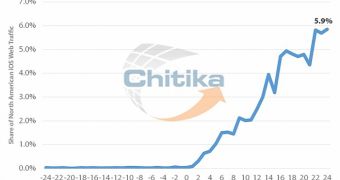Search-targeted advertising firm Chitika looked at tens of millions of iOS-based ad impressions from March 9 through March 11, 2014 across the U.S. and Canada and found that iOS 7.1 adoption was at almost 6 percent in the first 24 hours since the software became available.
In a report detailing the results of its study, Chitika says, “At 5.9%, North American iOS 7.1 adoption has progressed at a very similar rate to iOS 7.0.6. 24 hours following that release, iOS 7.0.6 users generated 6% of total iOS traffic, averaging to about 5% over the course of the full day.”
The firm strongly believes Apple can sustain this trend, saying, “Considering Apple’s update notification strategy, along with these two data points, it seems likely that future minor iOS 7 version updates will experience highly comparable levels of adoption.”
That is if Apple plans on incrementing iOS 7.1 in the first place. Details regarding iOS 8 are already leaking out by the dozen, and even some iOS 9 tidbits are beginning to arise.
However, as security buffs love to slam Apple for any new vulnerability found in iOS, a 7.1.1 update could be on the horizon. The iPhone maker also seems poised on adding feature after feature lately (CarPlay, Siri 2.0, accessibility options, UI tweaks, etc.), so a 7.2 release isn’t out of the question either. After all, iOS 8 isn’t expected to arrive until later this year.
While the Cupertino mammoth typically unveils a brand new version of its mobile OS at the summer-held Worldwide Developers Conference (WWDC) in June, shipping the software usually happens months after that, around the September quarter (alongside a new version of the iPhone).
So, if history is any indication, Chitika should be accurate in its prediction regarding potential “future minor iOS 7 version updates.”
Apple boasts that most of its customers are always running the latest version of the iOS operating system, unlike the Android camp, which is severely fragmented and open to security risks. Studies like Chitika’s confirm these claims.
Behind Apple’s high-adoption rate are several important factors, including the over-the-air (OTA) distribution method of these firmware updates, the clear indication that each update is important (if not imperative) in most cases and, most of all, the continued hype generated by the media.
While Android updates certainly pack a fair dose of excitement, iOS updates are generally better perceived. Apple customers are also better informed about the technicalities behind these updates, other studies have shown.

 14 DAY TRIAL //
14 DAY TRIAL //